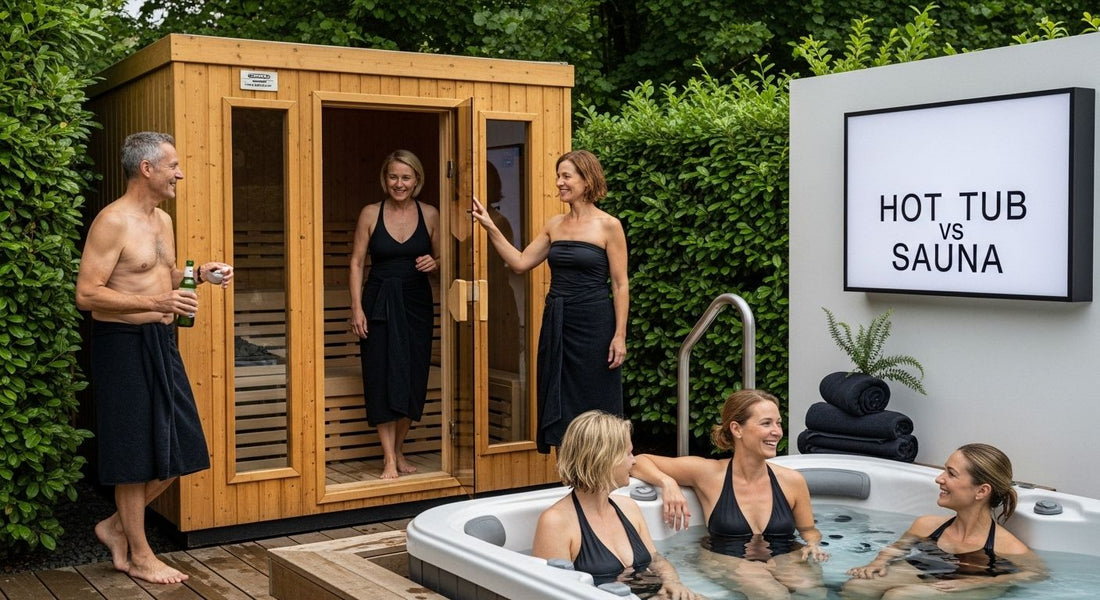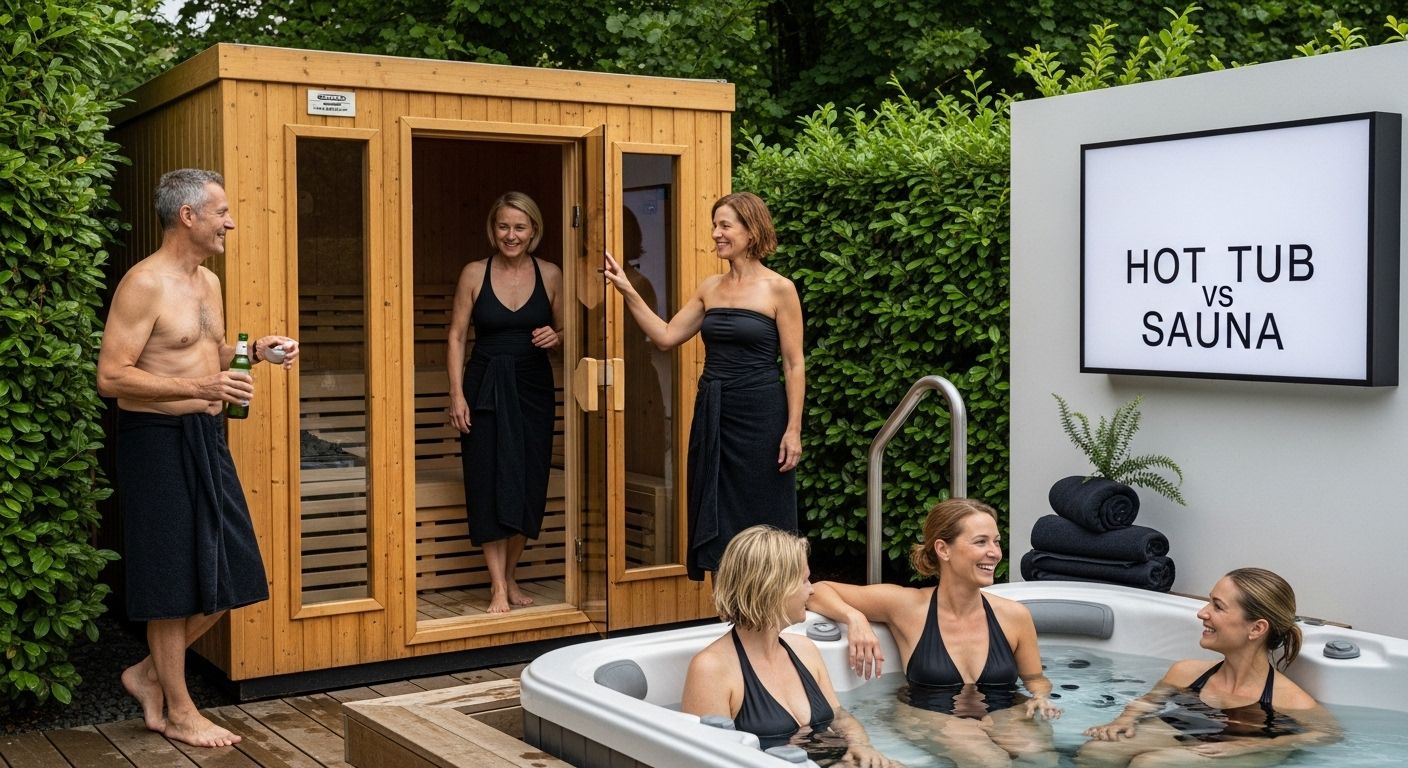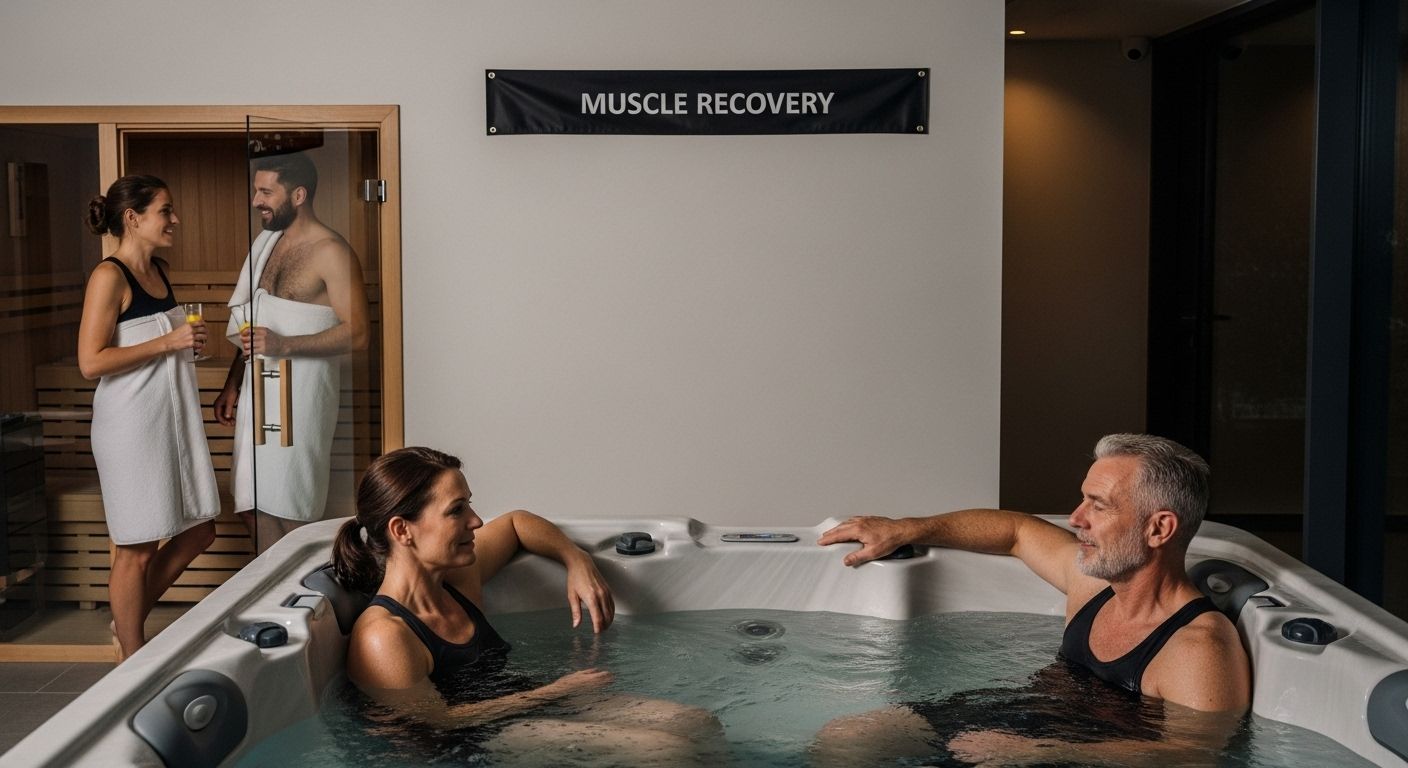
Understanding Hot Tub versus Sauna: Key Insights Explained

Hot tubs and saunas are popping up in backyards and wellness centers everywhere, promising rest, recovery, and community. But did you know that a traditional hot tub keeps water at a toasty 100 to 104 degrees Fahrenheit while a sauna can soar all the way up to 195 degrees? Most people assume it is just about warmth and a little relaxation. The surprising truth is these experiences offer far more than heat—they deliver real mental, physical, and even social benefits that go way beyond what most folks expect.
Table of Contents
- What Is A Hot Tub And How Does It Function?
- What Is A Sauna And Its Essential Functions?
- Health Benefits: Hot Tub Versus Sauna
- Social And Psychological Aspects Of Using Hot Tubs And Saunas
- Cost Considerations: Investing In Hot Tubs Or Saunas
Quick Summary
| Takeaway | Explanation |
|---|---|
| Hot tubs provide therapeutic heat and massage | They help alleviate muscle tension and improve circulation through warmth and water jets. |
| Saunas promote cardiovascular health | High temperatures in saunas enhance blood circulation and heart function through heat exposure. |
| Both support stress reduction | Hot tubs and saunas encourage relaxation and the release of endorphins, combating stress and anxiety. |
| Consider costs before purchase | Evaluate initial costs, installation, and ongoing maintenance for both hot tubs and saunas to make a sound investment. |
| Social interaction enhances wellness | Both environments encourage bonding and genuine conversations, boosting mental and emotional well-being. |
What is a Hot Tub and How Does it Function?
A hot tub represents a large, specially designed water vessel engineered to provide therapeutic warmth, relaxation, and hydrotherapy experiences. Unlike swimming pools, hot tubs are specifically constructed to maintain elevated water temperatures, typically ranging between 100 to 104 degrees Fahrenheit, creating an immersive environment for healing and leisure.
The Core Components of Hot Tub Technology
Hot tubs operate through a sophisticated system of integrated components designed to generate and maintain heated water. The primary mechanism involves a powerful electric heater that warms water circulated through an intricate network of pipes and jets. Water is drawn from the main pool through a suction intake, heated to the desired temperature, and then propelled back into the tub via strategically positioned jets.
Key technological components include:
- Heating Element: Transforms electrical energy into thermal energy
- Water Circulation Pump: Moves water through the system
- Control Panel: Allows users to adjust temperature and jet configurations
- Filtration System: Removes debris and maintains water cleanliness
Hydrotherapy and Wellness Benefits
According to research from the National Center for Biotechnology Information, hot tubs offer significant physiological benefits beyond simple relaxation. The combination of heated water and pressurized jets creates a therapeutic environment that can help alleviate muscle tension, improve blood circulation, and reduce stress.
The pressurized water jets provide targeted massage to specific muscle groups, promoting increased blood flow and accelerating recovery from physical exertion. Water buoyancy reduces gravitational pressure on joints, allowing muscles to relax more completely compared to traditional massage techniques. This makes hot tubs particularly beneficial for individuals managing chronic pain, athletic recovery, or seeking stress reduction strategies.
Modern hot tubs are designed with advanced ergonomic seating configurations, ensuring users can maximize therapeutic benefits while experiencing maximum comfort. The integration of precise temperature controls and customizable jet configurations allows individuals to personalize their hydrotherapy experience according to their specific wellness needs.
To provide a clear overview of the primary components of hot tubs and saunas, the following table organizes the essential elements found in each system, along with their core functions as described in the article.
| Component | Hot Tub Function | Sauna Function |
|---|---|---|
| Heating Element/Unit | Heats circulating water | Heats air inside the enclosure |
| Circulation Pump | Moves water through pipes and jets | Not typically required |
| Control Panel/Temperature Control | Adjusts water heat and jets | Manages ambient temperature |
| Filtration/Ventilation | Cleans water, removes debris | Manages air quality and humidity |
| Interior Materials | Ergonomic, water-resistant seating | Heat-resistant woods like cedar/hemlock |
What is a Sauna and Its Essential Functions?
A sauna represents a specialized heated room or enclosure designed to produce therapeutic warmth through controlled environmental conditions. These dedicated spaces are engineered to generate high temperatures, typically ranging between 150 to 195 degrees Fahrenheit, creating an intense heat environment that triggers profound physiological responses in the human body.
The Scientific Mechanism of Sauna Functionality
Saunas operate through a fundamental principle of thermal exposure, utilizing either traditional wood-burning heating methods or modern electric heating elements to generate consistent, intense heat. The heating system warms the enclosed space, causing significant increases in ambient and body temperature. This carefully controlled thermal environment stimulates multiple physiological mechanisms, including enhanced blood circulation, increased heart rate, and pronounced sweating.
Key technological elements of sauna design include:
- Heating Unit: Generates consistent high temperatures
- Ventilation System: Manages air circulation and humidity
- Temperature Controls: Allows precise heat management
- Interior Materials: Typically constructed from heat-resistant woods like cedar or hemlock
Physiological and Wellness Impacts
According to research from the Mayo Clinic, saunas provide a complex range of potential health benefits beyond simple heat exposure. The intense thermal environment triggers a series of adaptive physiological responses that can positively impact cardiovascular function, muscle recovery, and stress reduction.
The combination of elevated temperatures and controlled heat exposure induces a state of controlled thermal stress, which stimulates the body’s natural healing mechanisms. Sweating helps eliminate toxins, while increased heart rate mimics moderate cardiovascular exercise. Blood vessels dilate, improving circulation and potentially supporting overall cardiovascular health.
Modern saunas are engineered with sophisticated design principles that maximize user comfort and therapeutic potential. By integrating precise temperature regulation, ergonomic seating, and advanced material technologies, these spaces offer a holistic wellness experience that addresses both physical recovery and mental relaxation.
Health Benefits: Hot Tub versus Sauna
While hot tubs and saunas share foundational wellness principles, they offer distinct physiological experiences and health advantages. Understanding their unique therapeutic mechanisms helps individuals choose the most appropriate wellness modality for their specific health and recovery needs.
![]()
Cardiovascular and Circulation Benefits
Both hot tubs and saunas stimulate significant cardiovascular responses through thermal exposure, but their mechanisms differ subtly. Hot tubs utilize water pressure and warmth to enhance circulation, while saunas leverage dry heat to trigger similar physiological adaptations. Water immersion in hot tubs provides additional buoyancy, reducing gravitational stress on joints and muscles.
Comparative cardiovascular benefits include:
- Hot Tub: Gentle joint compression and massage-like jet interactions
- Sauna: Intense heat exposure promoting rapid cardiovascular adaptation
- Shared Mechanism: Increased heart rate and blood vessel dilation
Stress Reduction and Muscle Recovery
According to research from the Mayo Clinic Proceedings, both wellness modalities demonstrate remarkable potential for stress mitigation and muscular recuperation. Hot tubs offer targeted hydrotherapy through pressurized jets, allowing direct muscle tension relief. Saunas provide comprehensive heat therapy that encourages full-body relaxation and metabolic stimulation.
The thermal stress induced by these environments triggers the body’s natural healing mechanisms. Sweating helps eliminate toxins, while controlled heat exposure promotes endorphin release. Hot tubs excel in providing localized muscle relief, whereas saunas offer a more holistic thermal experience that impacts entire physiological systems.

The fundamental difference lies in their approach: hot tubs use water’s therapeutic properties, creating a massage-like environment, while saunas leverage dry heat to stimulate comprehensive bodily responses. Both represent powerful wellness tools designed to support physical recovery, stress reduction, and overall health optimization.
To clarify the unique characteristics of hot tubs and saunas for readers, the following table compares these two wellness experiences across several key dimensions, including temperature, therapeutic mechanisms, and primary benefits.
| Feature | Hot Tub | Sauna |
|---|---|---|
| Typical Temperature | 100-104°F (water) | 150-195°F (dry heat) |
| Core Mechanism | Heated water & water jets (hydrotherapy) | Heated air (dry or steam) |
| Primary Wellness Focus | Muscle relaxation, hydrotherapy, joint support | Cardiovascular health, detoxification, sweating |
| Key Components | Heater, jets, filtration, control panel | Heating unit, ventilation, wood interior |
| Stress Reduction | Targeted massage, buoyancy | Full-body heat exposure, endorphin release |
| Social Experience | Communal soaking, relaxation | Shared heat exposure, conversation |
| Estimated Cost Range | $3,000-$20,000 (plus installation/maintenance) | $2,000-$15,000 (plus installation/maintenance) |
Social and Psychological Aspects of Using Hot Tubs and Saunas
Hot tubs and saunas transcend mere physical wellness tools, emerging as powerful social spaces that foster connection, relaxation, and psychological rejuvenation. These environments create unique opportunities for interpersonal interaction, stress management, and mental health enhancement through carefully designed therapeutic experiences.
Social Interaction and Community Building
Both hot tubs and saunas serve as distinctive social platforms that encourage intimate conversations and relationship building. The controlled, relaxing environment reduces social barriers, allowing individuals to engage more authentically. Hot tubs particularly facilitate social interaction through their spacious design, enabling multiple people to comfortably share a communal space while experiencing shared warmth and relaxation.
Key social dynamics include:
- Reduced Inhibition: Warm environments lower psychological defense mechanisms
- Shared Experience: Mutual thermal exposure creates natural bonding opportunities
- Informal Communication: Relaxed settings promote more genuine interactions
Psychological Wellness and Stress Reduction
According to research from the Cleveland Clinic, these wellness environments provide profound psychological benefits beyond physical relaxation. The controlled thermal exposure triggers neurochemical responses that actively combat stress, anxiety, and depressive symptoms. Hot tubs and saunas create sensory experiences that interrupt typical stress patterns, allowing mental reset and emotional recalibration.
The immersive nature of these spaces encourages mindfulness and present-moment awareness. By removing external stimuli and providing a controlled, comfortable environment, individuals can achieve a meditative state that supports mental clarity and emotional balance. The combination of physical warmth and sensory isolation creates a unique psychological sanctuary that promotes overall mental wellness.
Ultimately, hot tubs and saunas represent more than physical wellness tools they are sophisticated psychological intervention spaces. They offer holistic experiences that address mental, emotional, and social dimensions of human well-being, transforming simple thermal exposure into comprehensive wellness opportunities.
Cost Considerations: Investing in Hot Tubs or Saunas
Investing in personal wellness technologies like hot tubs and saunas requires comprehensive financial analysis that extends beyond initial purchase price. Potential buyers must evaluate multiple economic factors, including upfront costs, installation expenses, ongoing maintenance, and long-term operational efficiency.
Initial Purchase and Installation Expenses
Hot tubs and saunas represent significant financial investments with substantial price variations. Traditional hot tubs range from $3,000 to $20,000, depending on size, features, and material quality. Saunas present similar price diversity, with basic models starting around $2,000 and premium installations reaching $15,000. Installation costs introduce additional financial considerations, including electrical work, site preparation, and potential structural modifications.
Key financial components include:
- Hot Tub Pricing: Ranges from budget models to luxury installations
- Sauna Investment: Varies based on construction type and technological features
- Installation Expenses: Electrical, structural, and site preparation costs
Operational and Maintenance Expenditures
According to research from the Open Health Tools, operational costs differ significantly between hot tubs and saunas. Infrared saunas demonstrate lower electricity consumption compared to traditional models, potentially offering more economical long-term usage. Hot tubs typically require more consistent maintenance, including chemical balancing, filter replacements, and higher energy consumption for continuous heating.
Annual operational expenses encompass multiple factors such as electricity usage, water treatment, replacement parts, and potential professional servicing. Hot tubs generally incur higher ongoing costs due to water circulation systems and complex mechanical components. Saunas, particularly infrared models, offer more predictable and potentially lower maintenance requirements.
Ultimately, selecting between a hot tub and sauna involves balancing immediate financial investment with anticipated long-term wellness benefits. Potential buyers should conduct thorough research, compare comprehensive cost projections, and consider personal health objectives when making their investment decision.
The following table summarizes initial and ongoing costs for both hot tubs and saunas to help readers make informed investment decisions based on financial and maintenance considerations outlined in the article.
| Cost Factor | Hot Tub | Sauna |
|---|---|---|
| Initial Purchase Price | $3,000 - $20,000 | $2,000 - $15,000 |
| Installation Expenses | Electrical, site, structural work | Electrical, construction, prep work |
| Maintenance Requirements | Chemical balancing, filter changes, water care | Lower (especially infrared models), cleaning, unit upkeep |
| Ongoing Energy Consumption | High (continuous water heating) | Lower (infrared), moderate (traditional) |
| Annual Professional Servicing | Recommended | Less frequent (infrared), sometimes for traditional |
Ready to Experience True Wellness Transformation?
If you have been reading about the unique benefits of hot tubs versus saunas, you may already see how personalized thermal therapy can dramatically improve your well-being. Whether you seek targeted muscle relief from hydrotherapy or the deep, detoxifying heat of a sauna, the challenge is finding the right solution that fits your health goals and your lifestyle. At Best Life Sauna, we understand your need for reliable, premium wellness products that deliver real results. Our selection covers everything from infrared and traditional saunas to relaxing hot tubs and swim spas, so you never have to compromise.

Why not take control of your wellness journey today? Explore our extensive range at Best Life Sauna and move closer to the comfort, relaxation, and health benefits you deserve. Act now to take advantage of free shipping on orders over $200 and discover how our dedicated support team can help you select the perfect wellness solution for your home. Your best life starts here—experience it firsthand.
Frequently Asked Questions
What are the main differences between a hot tub and a sauna?
Hot tubs are water-filled vessels designed for relaxation and hydrotherapy, typically maintaining temperatures between 100 to 104 degrees Fahrenheit. In contrast, saunas are heated rooms that reach higher temperatures, usually between 150 to 195 degrees Fahrenheit, and focus on dry heat exposure.
What are the health benefits of using a hot tub?
Hot tubs offer various health benefits, including muscle relaxation, improved blood circulation, reduced stress, and targeted hydrotherapy via pressurized jets, which can aid in recovery from physical exertion and chronic pain management.
How does a sauna impact my health?
Saunas promote cardiovascular health by increasing heart rate and circulation through intense heat exposure. They also encourage sweating, which helps detoxify the body, and provide stress reduction benefits by triggering the release of endorphins.
Can I use a hot tub and sauna together for enhanced wellness?
Yes, using a hot tub and sauna in combination can enhance wellness benefits. The hot tub provides targeted muscle relief and relaxation while the sauna promotes overall cardiovascular health and detoxification. Alternating between the two can optimize physical and mental well-being.

